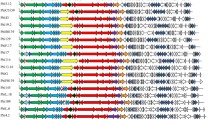Abstract
Bacteriophages attacking Streptococcus thermophilus, a lactic acid bacterium used in milk fermentation, are a threat to the dairy industry. These small isometric-headed phages possess double-stranded DNA genomes of 31 to 45 kb. Yoghurt-derived phages exhibit a limited degree of variability, as defined by restriction pattern and host range, while a large diversity of phage types have been isolated from cheese factories. Despite this diversity all S. thermophilus phages, virulent and temperate, belong to a single DNA homology group. Several mechanisms appear to create genetic variability in this phage group. Site-specific deletions, one type possibly mediated by a viral recombinase/integrase, which transformed a temperate into a virulent phage, were observed. Recombination as a result of superinfection of a lysogenic host has been reported. Comparative DNA sequencing identified up to 10% sequence diversity due to point mutations. Genome sequencing of the prototype temperate phage φSfi21 revealed many predicted proteins which showed homology with phages from Lactococcus lactis suggesting horizontal gene transfer. Homology with phages from evolutionary unrelated bacteria like E. coli (e.g. lambdoid phage 434 and P1) and Mycobacterium φL5 was also found. Due to their industrial importance, the existence of large phage collections, and the whole phage genome sequencing projects which are currently underway, the S. thermophilus phages may present an interesting experimental system to study bacteriophage evolution.
Similar content being viewed by others
References
Botstein D., Ann NY Acad Sci 354, 484-491, 1980.
Casjens S., Hatful G., and Hendrix R., Sem Virol 3, 383-397, 1992.
Kutter E., Gachechiladze K., Poglazov A., Marusich E., Shneider M., Aronsson P., Napuli A., Porter D., and Mesyanzhinov V., Virus Genes 11, 285-297, 1996.
Repoila F., Tétat F., Bouet J.-Y., and Krisch H.M., EMBO J 13, 4181-4192, 1994.
Everson, T.C., Bull. Intern Dairy Fed 263, 24-28, 1991.
Peitersen, N., Bull. Intern Dairy Fed 263, 1-43, 1991.
Hill C., FEMS Microbiol Rev 12, 87-108, 1993.
Daly C., Fitzgerald G.F., and Davis R. in Venema G. (ed.) Lactic Acid Bacteria: Genetics, Metabolism and Application. Kluwer Acad. Publisher Dordrecht, 1996, pp. 3-14.
Caldwell S.L., McMahon D.J., Oberg C.J., and Broadbent J.R., Appl Environ Microbiol 62, 936-941, 1996.
Accolas J.-P. and Spillmann H., J., Appl Bacteriol 47, 135-144, 1979.
Prevots F., Relano P., Mata M., and Ritzenthaler P., J Gen Microbiol 135, 3337-3344, 1989.
Neve H., Krusch U., and Teuber M., Appl Microbiol Biotechnol 30, 624-629, 1989.
Benbadis L., Faelen M., Slos P., Fazel A., and Mercenier A., Biochimie 72, 855-862, 1990.
Larbi D., Colurin C., Ronselle L., Decaris B., and Simonet J.M., Lait 70, 107-116, 1990.
Fayard B., University of Nancy, thesis 1993.
Sebastiani H. and Jäger H., Milchwissenschaft 48, 25-29, 1992.
Sozzi T., Maret R., and Poulin J.M., Appl Environ Microbiol 32, 131-137, 1976.
Brüssow H., Frémont M., Bruttin A., Sidoti J., Constable A., and Fryder V., Appl Environ Microbiol 60, 4537-4543, 1994.
Carminati D. and Giraffa G., J Dairy Res. 59, 71-79, 1992.
Fayard B., Haefliger M., and Accolas J.-P., J Dairy Res. 60, 385-399, 1993.
Brüssow H. and Bruttin A., Virology 212, 632-640, 1995.
Brüssow H., Probst A., Frémont M., and Sidoti J, Virology 200, 854-857, 1994.
Singer B.S. and Westlye J., J Mol Biol 202, 233-243, 1988.
Davis R.W. and Parkinson J.S., J Mol Biol 56, 403-429, 1971.
Bruttin A. and Brüssow H., Virology 219, 96-104, 1996.
Highton P.J., Chang Y., and Myers R.J., Mol Microbiol 4, 1329-1340, 1990.
Larbi D., Decaris B., and Simonet J.-M., J Dairy Res 59, 349- 357, 1992.
Moineau S., Walker S.A., Holler B.J., Vedamuthu E.R., and Vandenbergh P.A., Appl Environ Microbiol 61, 2461-2466.
Boyce J.D., Davidson B.E., and Hillier A.J., Appl Environ Microbiol 61, 4089-4098, 1995.
Kim S.G. and Batt C.A. Gene 98, 95-100, 1991.
Kim S.G., Bor Y.-C., and Batt C.A. J Dairy Sci 75, 1761-1767, 1992.
Mondragon A., Subbiah S., Almo S.C., Drottar M., and Harrison S.C., J Mol Biol 205, 189-200, 1989.
Birkeland N.-K. Can J Microbiol 40, 658-665, 1994.
Ziegelin G., Scherzinger E., Lurz R., and Lanka E. EMBO J 12, 3703-3708, 1993.
Hatfull G.F. and Sarkis G.J., Mol Microbiol 7, 395-405, 1993.
Martin A.C., Lopez R., and Garcia P., J Viro l 70, 3678-3687, 1996.
Lopez R., Garcia J.L., Garcia E., Ronda C., and Garcia P., FEMS Microbiol Lett 100, 439-448, 1992.
Wood B.J.B. and Holzapfel W.H. The genera of lactic acid bacteria. Blackie Academic and Professional, Glasgow 1992.
Schleifer K.H., Kraus J., Dvorak C., Klippe-Bälz R., Collins M.D., and Fischer W., System. Appl Microbiol 6, 183-195, 1985.
Jarvis A.W., Appl Environ Microbiol 47, 343-349, 1984.
Le Marrec C., van Sinderen D., Walsh L., Stanley E., Vlegels E., Moineau S., Heinze P., Fitzgerald G., and Fayard B., Appl Environ Microbiol 63, 3246-3253, 1997.
Neve H., Zenz K.I., Desiere F., Koch A., Heller K.J., and Brüssow H., Virology in press.
Stanley E., Fitzgerald G.F., Le Marrec C., Fayard B., and van Sinderen D., Microbiology 143, 3417-3429, 1997.
Bruttin A., Desiere F., Lucchini S., Foley S., and Brüssow H., Virology 233, 136-148, 1997.
Desiere F., Lucchini S., Bruttin A., Zwahlen M.-C., and Brüssow, Virology 234, 372-382, 1997.
Desiere F., Lucchini S., and Brüssow H., Virology in press.
Bruttin A., Desiere F., d'Amico N., Guérin J.-P., Sidoti J., Huni B., and Brüssow H., Appl Environ Microbiol 63, 3144-3150, 1997.
Bruttin A., Foley S., and Brüssow H., Virology 237, 148-158, 1997.
Author information
Authors and Affiliations
Rights and permissions
About this article
Cite this article
Brüssow, H., Bruttin, A., Desiere, F. et al. Molecular Ecology and Evolution of Streptococcus thermophilus Bacteriophages—a Review. Virus Genes 16, 95–109 (1998). https://doi.org/10.1023/A:1007957911848
Issue Date:
DOI: https://doi.org/10.1023/A:1007957911848




